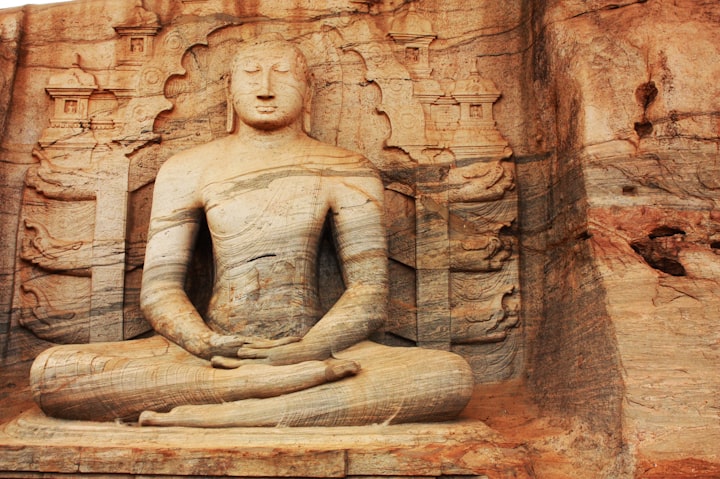Instability is inevitable
Considering Buddhism during these uncertain times

Suffering is a common word within Buddhism. To the Buddhist, to suffer means to endure instability and uncertainty. Buddhists learn to accept that nothing ever remains the same. Since most of us can admit there is no shortage of uncertainty going around in our lives during these pandemic times, it could be helpful and even useful to consider Buddhism. The Middle Way, or Buddhism, is not about an omniscient god or gods. It is about the teaching of a natural yet extraordinary man.
An old, hard to find documentary follows the path of Buddhism. From it, we can learn how this peaceful journey toward inner calm and happiness can be followed.
Ronald Erye made a series of films, entitled The Long Search, in the 1970s traveling around the world considering Man’s Religious Quest. The documentary, The Buddhist Path—Footprint of the Buddha is the first Buddhist documentary in the series. It begins in Polonnaruwa, Sri Lanka, where Erye has traveled to learn about Theravada Buddhism. Erye has an excellent guide in Ven Ananda Maitreya, one of the most respected Sri Lankan monks in living memory. The film offers a look at the monk’s simple life in his temple in the up-country region at Balangoda. We also see the workings of a Sunday school, and a samanera ordination of a young boy.
We learn first from the venerable monk that the stillness of a Buddha statue is an invitation to emulate its stillness and restraint. Later, in the Sunday school visited in the documentary, the children tell stories about the former lives of the Buddha, including a story about a time when the Buddha was a partridge.
Erye says that the Theravada Buddhism equivalent to The Lord’s Prayer may be the chant: “I take the Buddha as my refuge. I take the dhamma (or dharma) as my refuge. I take the sangha as my refuge.” This Buddhist creed is called the 3 Jewels or 3 Refuges. It means, roughly: I take refuge in the enlightened one or the awakened one, Buddha. I take refuge in the truth he saw and preached, or the dhamma. I take refuge in the community of monks who live by the teaching and promote it in the world, or the sangha.
The documentary also takes Erye to Waturawila, the headquarter of a forest-dwelling sect. Erye then visits another forest monastery and speaks to a monk living in a cave there. Along the way, Erye learns about Buddhism, seems to understand it well, and shares what he comprehends with viewers.
What little is known historically about Siddhartha or what is historically credible if not verifiable is that he was born in a long-since vanished city called Kapilavastu that existed in the small clan-ruled Shakya Kingdom. The site was in or near what is now Nepal. Siddhartha was born into the kshatriya or warrior caste and was the crown prince, or next in line to rule the kingdom after his father.
According to tradition, Siddhartha Gautama, at the age of thirty-five, sat under a Bodhi Tree in Bodh Gaya, meditated, and woke up to the truth, or became enlightened to become the Buddha. At the time Siddhartha Gautama was dying of starvation from practicing harsh ascetic disciplines of self-denial. A starving Siddhartha Gautama accepted an offering of rice-milk porridge from Sujata, a woman who had taken pity on his emaciated body. This random act of kindness by Sujata would change the world.
After Siddhartha Gautama was revived from the brink of starving to death, he recommitted to his quest, aware of why he had failed and knowing a middle path must exist by which success would emerge from his failure.
During meditation, Siddhartha became enlightened to the understanding that suffering was caused by clinging to permanent states of being in a world of impermanence. If people could accept that life was about change, then suffering could end. Buddhists hold that attachments in the belief that anything lasts serve only to trap a person in an endless cycle of craving, striving, rebirth, and death. The cessation of attachment leads to Nirvana.
The Buddha is called a natural, extraordinary man, but stories about his mother’s pregnancy and his birth do contain tales of miracles. For example, it is believed that the infant Siddhartha took seven steps upon being born and vowed that birth was to be his last rebirth.
What does it mean to be a Buddhist? A layperson Buddhist observes the following five precepts: not to destroy life, not to steal, not to misuse sex, not to lie, and not to take intoxicants. A novice monk, like the boy in the samanera ordination shown in the documentary, takes those five precepts and adds five more: not to eat later than noon; not to dance, sing, or attend shows; not to decorate himself (or herself in the case of nuns, but there were no nuns in Sri Lanka when the documentary was filmed); not to use soft beds; and, finally, not to handle gold or silver.
Buddhists do not accept that there is one omniscient god. They believe in depending upon themselves, rather than on a higher power. Buddhists believe in accepting that change cannot be prevented or stopped. Inherent to The Middle Way is the idea that nothing is solid and unchanging enough to cling to, therefore we must all learn the opposite of attachment—the art of letting go.
Resources:
View more dharma documentaries here.
Siddhartha Gautama in the Ancient History Encyclopedia
About the Creator
Meadow Leight-Bell
Meadow Leight-Bell has a BA in English from the University of Arkansas at Little Rock. She writes from Lawrence, Kansas, with her trusty shepkita, Crash.
Cover Photo by Free Steph on Unsplash
Twitter: @twitz_end






Comments
There are no comments for this story
Be the first to respond and start the conversation.